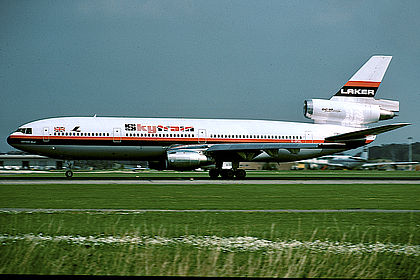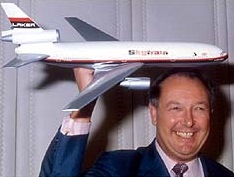
As a teenage plane spotter in the 1970s I was always intrigued by the Icelandic airline Loftleidir (or Loftleiðir to the natives), but I never really knew much about it beyond the fact that amongst my peers it was considered an impressive “cop”. In actual fact, it was the world’s first budget airline. Long before Ryanair was condemning its thrifty clientele to a lengthy wait on the tarmac in the pouring rain to board one of its three hundred or so Boeing 737s, or rushing them a tenner or more for airborne culinary fare that the hardiest McDonald’s enthusiast would wince at, Loftleidir was offering cut-price transatlantic travel through the twin expedients of minimising operating costs and exploiting Iceland’s unique position as a mid-way stopover point between Europe and the USA.
But the Norse turboprop express aside, the brand which really brought the concept of the low-cost airline to the masses was the innovative UK carrier Laker Airways, founded by the pioneering British businessman Sir Freddie Laker. Originally established in 1966 as a cargo and charter service specialising in travel to the Mediterranean and the Canary Islands, for some while the service flew short-haul BAC One-Elevens from London Gatwick and later also out of West Berlin.
Significant cost savings
It was around this time that it occurred to Laker that significant cost savings could be made by means of some simple alterations to established operational procedures, savings which could potentially be passed on to the customer. Reducing take-off thrust meant less wear and tear to the aircraft’s Rolls Royce Spey engines, which in turn meant the planes spent less time out of service being overhauled. Crews were instructed to tune into other jets taking off ahead of them in order to obtain information about their ascent, enabling them to safely climb more quickly and thus more economically. And, years before the idea had suggested itself to easyJet and other modern economy air passenger services, Laker cut its baggage allowance and limited the number of passengers to below capacity in order to allow its One-Elevens to fly more lightly and thereby increase their range.
In 1969 the airline made its move into the market for a low-cost, “no frills” service to the United States and purchased two ageing Boeing 707s with that purpose in mind. Projections showed that even when charging a reduced rate of £37.50 per seat, only 63% of passenger capacity would need to be reached in order for a flight to break even financially. However when, in the early 1970s, Laker moved to take ownership of the first of several wide-bodied McDonnell-Douglas DC10s, that figure was further revised down to an incredible 52%. Furthermore, by reaching out to a new market which had hitherto been excluded by prohibitive pricing from any prospect of transatlantic travel, Laker believed that it had created its own unique catchment rather than having to compete with more established airlines for a share of their own customer base. The Skytrain had arrived.
Rival independent airlines

Except, of course, for one thing. Laker Airways still required permission from the aviation authorities in both the UK and the US to operate its desired routes. And needless to say, both national flag carriers and rival independent airlines were less than happy with the idea. Most significantly, the rules in Britain granting preferential terms to one nominated “second airline” meant that British Caledonian had first pick when it came to all the most popular routes, and it wasn’t minded to surrender them anytime soon.
The battle for Skytrain took the best part of the 1970s to play out, and in the meantime Laker had to find the best alternative options for putting its existing fleet to some use. The 707s entered weekly service on behalf of International Caribbean Airways, in which Laker had a major shareholding, on a low-fare venture between Luxembourg and Barbados. This was soon to be expanded into a twice-weekly service and extended to incorporate Gatwick. In 1973 Laker was able to take advantage of new, simplified air charter regulations to operate a series of ad hoc services into Toronto from Manchester and Prestwick. Despite including meals, films and a free bar passengers paid just £45 return.
In 1976 the airline took delivery of its fourth DC10-10 in anticipation of its long-awaited Skytrain service between Gatwick and New York’s John F. Kennedy airport, which was finally launched after years of wrangling in September 1977. First year profits of over £2 million were recorded, and permissions were later granted to fly to Los Angeles and Miami. By the early 1980s Laker had also acquired licences to access Washington DC, Detroit, Seattle, Oakland and Chicago, although it did not have the aircraft immediately available to serve these routes, and by this time financial difficulties had begun to manifest themselves.
The Skytrain revolution
Laker Airways was declared insolvent in February 1982. Despite its best efforts it lacked the financial muscle to ride out the recession of the early 1980s in the face of fierce and sometimes concerted competition from the much larger national and independent airlines. Its business model required it to operate all the year round, but the nature of its customer base meant its appeal was largely limited to cash-limited holidaymakers rather than to the kind of client more likely to travel during the winter months. When the major airlines combined to drop their fares to similar levels, the Skytrain revolution became doomed to fail.
Sir Freddie sued British Airways, British Caledonian, US flag-carriers Trans World Airlines and Pan Am plus several other airlines, and out-of-court settlements between them all netted him in the region of $95 million as a going-away present from the industry.
The demise of Laker Airways came as a blow to budget flyers the world over, not to mention to plane spotters. But its legacy lives on today in the guise of a multitude of cut-price airlines, which sometimes offer a seat on a flight to a place in the sun for the cost of a couple of pints (in London at least). Travel light, don’t travel hungry and don’t be too fussed about when you board the plane or whereabouts you sit when you board it, and it’s an experience that few cannot easily afford. Many of those taking advantage will be too young even to have heard of the Laker Skytrain but, once again, the 1970s was where it all began.

If you enjoyed reading this article, make sure you stay updated with all Phil’s latest blog posts by signing up to receive his free Newsletter. You can unsubscribe at any time and your details will never be shared with any third party. Click here to sign up today.
Hi Phil, and thanks for dropping this article onto the Armstrong and Burton Series Facebook page. Fascinating stuff, so we re-shared it with the link. Looking forward to reading some more.
In 1976 I flew for the first time from manchester to toronto on a laker airways DC10. The fact that laker airways offered such a oow cozt air fare enabled the regular person on the street the opportunity to fly across the atlantic and throughout europe. I commend sir Freddie for what he did to the airline industry and am thankful for entrepreneurs like him that made flying to see family a reality. Thank you sir Freddie Laker